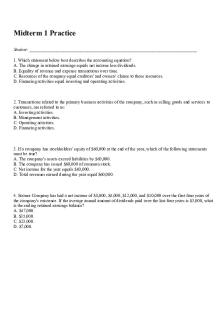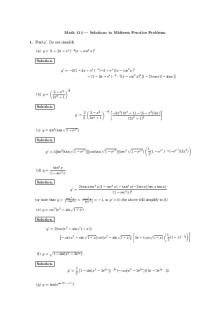BIOM3200-W21 Midterm 1 extra practice PDF

| Title | BIOM3200-W21 Midterm 1 extra practice |
|---|---|
| Author | Nicholas Carbone |
| Course | biomedical physiology |
| Institution | University of Guelph |
| Pages | 5 |
| File Size | 54.4 KB |
| File Type | |
| Total Downloads | 163 |
| Total Views | 213 |
Summary
Extra practice questions for Midterm 1MULTIPLE CHOICE QUESTIONS Which of the following qualify as an endocrine disorder? A. diabetes mellitus B. hypothyroidism C. acromegaly D. both A and C are correct E. all of the above Which of the following is a hypothalamic hormone? A. pendrin B. triiodothyroni...
Description
Extra practice questions for Midterm 1 MULTIPLE CHOICE QUESTIONS 1. Which of the following qualify as an endocrine disorder? A. diabetes mellitus B. hypothyroidism C. acromegaly D. both A and C are correct E. all of the above 2. Which of the following is a hypothalamic hormone? A. pendrin B. triiodothyronine (T3) C. thyroglobulin D. thyroid stimulating hormone (TSH) E. thyrotropin releasing hormone (TRH) 3. Which of the following describes cortisol? A. mineralocorticoid synthesized in the zona glomerulosa B. sex steroid synthesized in the zona fasiculata C. glucocorticoid synthesized in the zona fasiculata D. catecholamine synthesized in the zona reticularis E. corticosterone synthesized in the zona pellucida 4. Which of the following is a hypothalamic hormone in the somatotropic axis? A. growth hormone-releasing hormone (GHRH) B. growth hormone-inhibiting hormone (GHIH) C. growth hormone-binding protein (GHBP) D. both A and B are correct E. all of the above 5. Overproduction of growth hormone in growing humans is associated with which of the following? A. pituitary dwarfism B. Laron-type dwarfism C. alopecia D. gigantism E. acromegaly
Page 1 of 5
6. Which of the following relates to calcium regulation in the body? A. 1,25-dihydroxyvitamin D3 helps maintain calcium balance B. osteoclasts help build bone C. osteoblasts help dissolve bone D. decreased PTH promotes dissolution of hydroxyapatite from bone E. none of the above 7. Which protein brings iodide from the follicular cell into the colloid? A. thyroid peroxidase (TPO) B. thyroglobulin C. pendrin D. follicle stimulating hormone (FSH) E. none of the above 8. Which of the following hormones travel freely in the blood, dissolved in plasma? A. thyroxine (T4) B. adrenaline/epinephrine C. calcitonin D. aldosterone E. all of the above 9. Which of the following occurs after too much salt intake? A. blood osmolarity decreases C. the posterior pituitary gland synthesizes anti-diuretic hormone (ADH) B. the hypothalamus secretes ADH D. glomerular filtration rate increases E. none of the above 10. Where are thyroid hormone receptors located within the target cell? A. in the cell cytoplasm B. in the nucleus C. on the plasma membrane D. on mitochondria E. all of the above 11. Which of the following is NOT involved in the synthesis of thyroxine (T4)? A. monoiodotyrosine B. thyroglobulin C. pendrin D. peroxidase E. iodide
Page 2 of 5
12. Which of the following is NOT a clinical problem within the hypothalamic – anterior pituitary – thyroid axis? A. Cretinism B. Goiter C. Addison’s Disease D. Grave’s Disease E. Hypothyroidism 13. Which of the following is NOT TRUE about the somatotropic axis? A. growth hormone is also called somatotropin B. somatomedins can act on cartilage C. growth hormone stimulates synthesis of insulin-like growth factor (IGF)-1 from liver and other tissues D. sleep is associated with a decrease in growth hormone secretion E. growth hormone stimulates chondrocytes for bone growth 14. Which of the following is NOT TRUE about parathyroid hormone (PTH)? A. synthesized in the parathyroid glands B. synthesized by parafollicular cells C. levels increase when plasma Ca2+ levels begin to fall D. raises blood Ca2+ by stimulating osteoclasts to resorb bone E. stimulates kidneys to reabsorb Ca2+ 15. Which of the following describes insulin? A. synthesized by the beta cells of the pancreas B. signals through a tyrosine kinase second messenger system C. exerts opposite actions as glucagon to achieve blood glucose homeostasis D. promotes glycogenesis E. all of the above 16. Fill in the blanks, in order. If a person is dehydrated, then blood osmolarity is _____ and total blood volume is _____. This leads to stimulation of osmoreceptors in the hypothalamus, followed by _____ thirst and _____ anti-diuretic hormone (ADH) secretion. A. increased, increased, increased, increased B. increased, reduced, increased, increased C. increased, reduced, reduced, increased D. increased, reduced, increased, reduced E. decreased, increased, increased, increased 17. Through which of the following does blood leaves the glomerulus? A. efferent arteriole B. afferent arteriole C. efferent venule D. afferent venule E. none of the above Page 3 of 5
18. Which of the following is true about angiotensinogen in the renin-angiotensin-aldosterone system (RAAS)? A. the liver produces angiotensinogen B. angiotensinogen is converted to angiotensin I by angiotensin converting enzyme (ACE) C. angiotensinogen promotes renin secretion D. angiotensinogen is a vasoconstrictor E. none of the above 19. Which part of the nephron is most responsible for extruding salts to the renal medulla? A. glomerulus B. ascending loop of Henle C. proximal convoluted tubule D. collecting duct E. distal convoluted tubule 20. Which of the following is NOT a region of the kidney? A. cortex B. medulla C. pyramid D. adrenal E. pelvis 21. Which of the following is NOT a component of the nephron? A. ureter B. bowman’s capsule C. distal convoluted tubule D. descending loop of Henle E. proximal convoluted tubule
22. Which of the following is NOT TRUE about regulation of glomerular filtration rate (GFR)? A. GFR remains relatively constant B. GFR is around 125 mL/min by the 2 kidneys C. GFR is myogenically autoregulated D. if blood hydrostatic pressure rises, the afferent arteriole dilates E. if blood hydrostatic pressure falls, the efferent arteriole constricts
23. Which of the following is NOT involved in autoregulation of glomerular filtration rate (GFR)? A. juxtaglomerular apparatus B. juxtaglomerular granular cells C. macula densa D. afferent arteriole E. renin angiotensin-aldosterone system
Page 4 of 5
24. Which of the following is NOT TRUE about the formation of urine? A. filtration occurs in the renal corpuscle B. reabsorption returns useful solutes and water to the filtrate C. secretion helps eliminate wastes from blood D. the filtrate is most concentrated at the base of the Loop of Henle E. urine is more concentrated than blood 25. Which of the following is NOT a property of the ascending limb of the Loop of Henle? A. permeable to salt B. permeable to water C. active transport D. thicker than the descending limb of the Loop of Henle E. transitions into the distal convoluted tubule
FILL-IN-THE-BLANK QUESTIONS 26. __________ hormones are synthesized from cholesterol.
27. __________ and __________ hormones are transported in the blood bound to carrier proteins.
28. The hormone __________ stimulates the enzyme __________ to free glucose for release from the liver.
29. The renal corpuscle consists of the __________ and the __________ that encloses it.
30. The countercurrent __________ system relies on the __________, which is a capillary network.
Page 5 of 5...
Similar Free PDFs

Chapter 1 Extra Practice
- 3 Pages

Extra Practice Problem 1
- 3 Pages

Practice midterm 1 2021s
- 14 Pages

CSE114 Practice Midterm 1
- 12 Pages

Midterm 1 Practice
- 19 Pages

Midterm 1 Practice
- 12 Pages

Midterm Practice 1 Solutions
- 9 Pages

Pexam 1 - practice midterm 1
- 1 Pages

Extra Practice Week 9
- 2 Pages

Extra - Percent Comp Practice
- 1 Pages

Extra Practice Chapter 11
- 2 Pages

Extra Practice Week 6
- 2 Pages

Extra Practice Week 10
- 2 Pages

Extra Practice Week 7
- 2 Pages
Popular Institutions
- Tinajero National High School - Annex
- Politeknik Caltex Riau
- Yokohama City University
- SGT University
- University of Al-Qadisiyah
- Divine Word College of Vigan
- Techniek College Rotterdam
- Universidade de Santiago
- Universiti Teknologi MARA Cawangan Johor Kampus Pasir Gudang
- Poltekkes Kemenkes Yogyakarta
- Baguio City National High School
- Colegio san marcos
- preparatoria uno
- Centro de Bachillerato Tecnológico Industrial y de Servicios No. 107
- Dalian Maritime University
- Quang Trung Secondary School
- Colegio Tecnológico en Informática
- Corporación Regional de Educación Superior
- Grupo CEDVA
- Dar Al Uloom University
- Centro de Estudios Preuniversitarios de la Universidad Nacional de Ingeniería
- 上智大学
- Aakash International School, Nuna Majara
- San Felipe Neri Catholic School
- Kang Chiao International School - New Taipei City
- Misamis Occidental National High School
- Institución Educativa Escuela Normal Juan Ladrilleros
- Kolehiyo ng Pantukan
- Batanes State College
- Instituto Continental
- Sekolah Menengah Kejuruan Kesehatan Kaltara (Tarakan)
- Colegio de La Inmaculada Concepcion - Cebu

